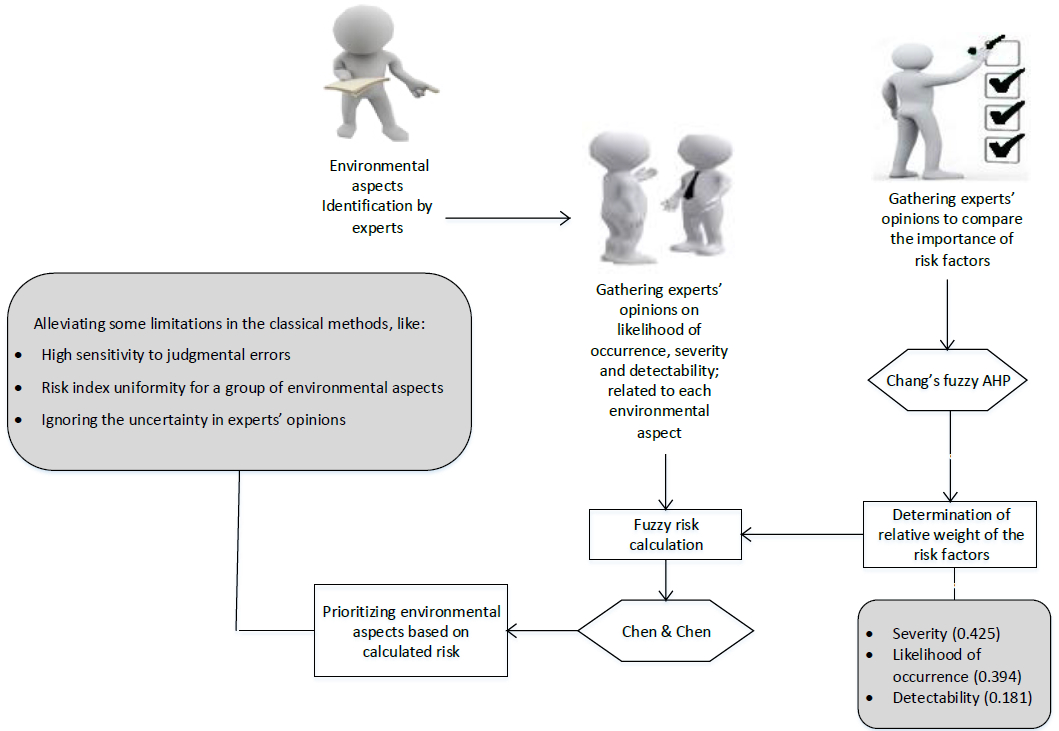Volume 9, Issue 3 (9-2019)
J Health Saf Work 2019, 9(3): 200-211 |
Back to browse issues page
Download citation:
BibTeX | RIS | EndNote | Medlars | ProCite | Reference Manager | RefWorks
Send citation to:



BibTeX | RIS | EndNote | Medlars | ProCite | Reference Manager | RefWorks
Send citation to:
Noori H, Cheraghi M, Eslami Baladeh A. A hybrid fuzzy MADM model for environmental risk assessment: a case of an oil and gas exploitation area. J Health Saf Work 2019; 9 (3) :200-211
URL: http://jhsw.tums.ac.ir/article-1-6166-en.html
URL: http://jhsw.tums.ac.ir/article-1-6166-en.html
1- Department of Health, Safety and Environment (HSE), National Iranian Oil Company (NIOC), Tehran, Iran
2- Department of Health, Safety and Environment (HSE), School of Environment, College of Engineering, University of Tehran, Tehran, Iran ,cheraqi@ut.ac.ir
3- Department of Industrial Engineering and Management System, Amirkabir University of Technology, Tehran, Iran
2- Department of Health, Safety and Environment (HSE), School of Environment, College of Engineering, University of Tehran, Tehran, Iran ,
3- Department of Industrial Engineering and Management System, Amirkabir University of Technology, Tehran, Iran
Abstract: (16890 Views)
Introduction: Evaluating environmental risks in the oil and gas industry is essential to prevent irreparable damage to the environment. Using classical methods for prioritizing environmental risks does not achieve high-reliable results. Therefore, the aim of this study is to minimize the limitations of classical methods in a typical oil and gas production zone, by using fuzzy logic and Multi Attribute Decision Making (MADM) approach.
Material and Methods: After forming an identification and assessment team including experienced experts from different organizational units in a region of exploitation of oil and gas, values of each risk factor (likelihood of occurrence, severity and detectability) related to identified environmental risks are determined according to their qualitative opinions represented by linguistic variables. Relative weights of the risk factors are calculated by applying the group Analytic Hierarchy Process (AHP) in a fuzzy environment on expert opinions. Then, fuzzy aggregation in the linear form by considering the weight of the risk factors and a method that is developed based on the center of gravity are employed in evaluation and ranking of the risks.
Results: In this study, the severity factor has the most important contribution in risk assessment compared to the other risk factors, since it has the highest relative weight. Raw sewage aspect resulted from absence of appropriate treatment system has the highest priority and spilling over of acid that is caused by chiller cleaning stands at the second position in the identified environmental risks.
Conclusion: The results demonstrate that although the proposed methodology requires greater time than classical methods, it is able to determine the risk ranking more practically because of minimizing the limitations of classical methods: high sensitivity to judgmental errors, considering some risks in the same index group and ignoring uncertainty in experts’ opinions. Proposed method is a proper alternative for classical environmental risk assessment technique, and capable of prioritization and evaluation risks in terms of safety and health.
Material and Methods: After forming an identification and assessment team including experienced experts from different organizational units in a region of exploitation of oil and gas, values of each risk factor (likelihood of occurrence, severity and detectability) related to identified environmental risks are determined according to their qualitative opinions represented by linguistic variables. Relative weights of the risk factors are calculated by applying the group Analytic Hierarchy Process (AHP) in a fuzzy environment on expert opinions. Then, fuzzy aggregation in the linear form by considering the weight of the risk factors and a method that is developed based on the center of gravity are employed in evaluation and ranking of the risks.
Results: In this study, the severity factor has the most important contribution in risk assessment compared to the other risk factors, since it has the highest relative weight. Raw sewage aspect resulted from absence of appropriate treatment system has the highest priority and spilling over of acid that is caused by chiller cleaning stands at the second position in the identified environmental risks.
Conclusion: The results demonstrate that although the proposed methodology requires greater time than classical methods, it is able to determine the risk ranking more practically because of minimizing the limitations of classical methods: high sensitivity to judgmental errors, considering some risks in the same index group and ignoring uncertainty in experts’ opinions. Proposed method is a proper alternative for classical environmental risk assessment technique, and capable of prioritization and evaluation risks in terms of safety and health.
Type of Study: Research |
Received: 2019/10/1 | Accepted: 2019/10/1 | Published: 2019/10/1
Received: 2019/10/1 | Accepted: 2019/10/1 | Published: 2019/10/1
Send email to the article author
| Rights and permissions | |
 |
This work is licensed under a Creative Commons Attribution-NonCommercial 4.0 International License. |






